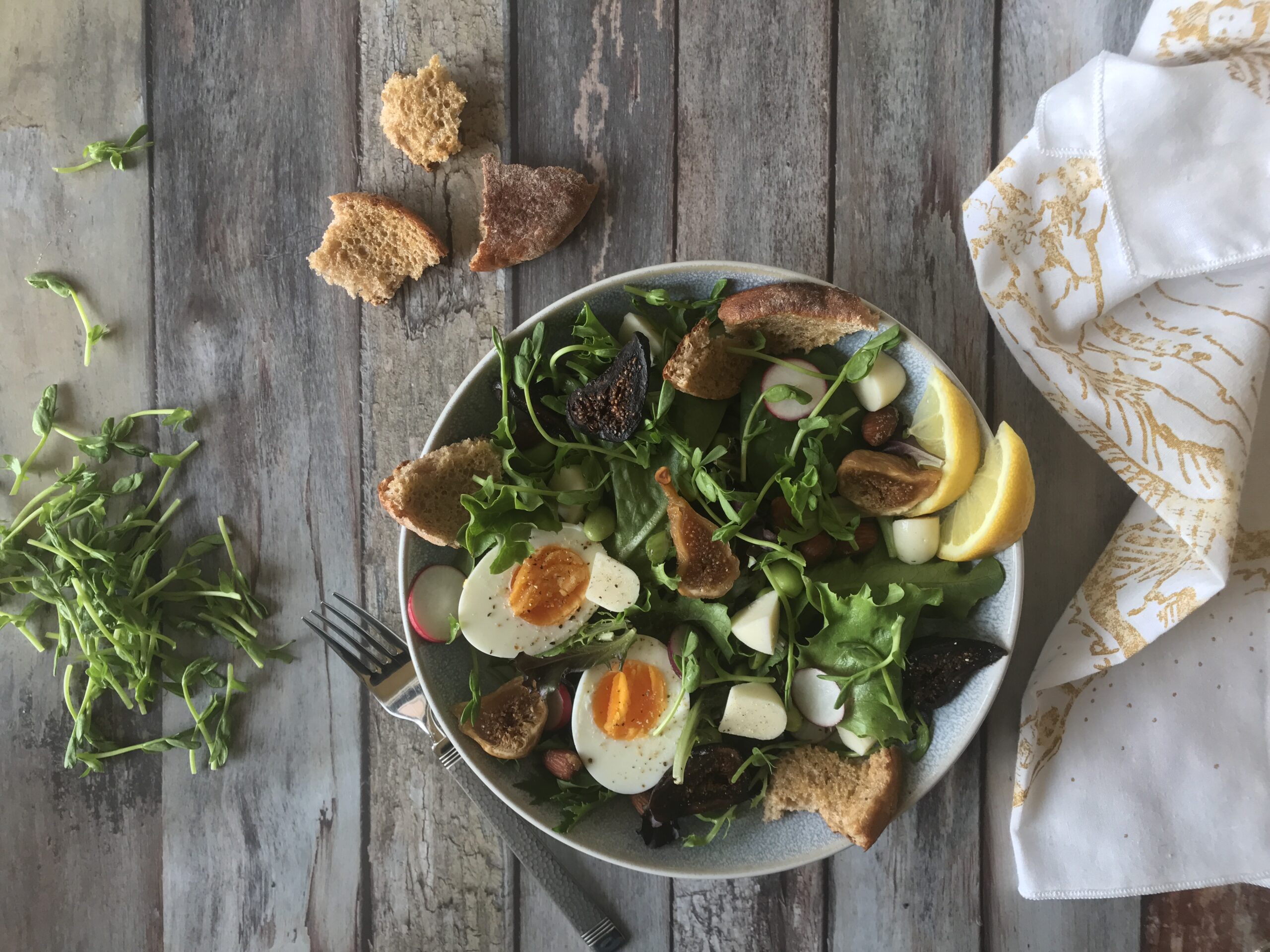
We chatter about fat and carbohydrate, but Americans are preoccupied with protein. It’s no surprise – protein is associated with positive outcomes like health, strength and performance (2). The word “protein” comes from the Greek “proteios” which means “first place.” (1).
Plant protein is a hot sub-category of the protein craze, driven by interest in protecting health and the environment (2). Plant-based products are flooding the market and people are eager to try them, especially meat and dairy alternatives (2).
Questions arise, such as: Am I getting enough protein? I address many in my article Let’s Talk Protein… for Valley Fig Growers, the producers of Sun-Maid and other California Dried Figs. Here’s a summary of key points – link to the article for more details.
What is protein?
Proteins are long, complex chains of amino acids, that are broken down into individual units during digestion. The body uses this pool of amino acids to repair and build new cells and tissues. Twenty amino acid “building blocks” are needed; nine are essential to get via the diet, the others can be made in the body. The body will use protein as a source of energy, too, if there is not enough carbohydrate or fat available (3,5).
What Foods Contain Protein?
Protein is found in a wide variety of plant and animal foods (3,7). Most people can meet their protein needs with food and do not need supplements (4,11). Check out the article for a chart of protein in foods ranging from meat and beans, to nuts and bread.
Are Plant Proteins as Nutritious as Animal Proteins?
Animal-proteins are efficient, concentrated sources of protein because they contain all 9 essential amino acids in appropriate amounts for protein building. Some plants have complete amino acid profiles too, but most are low in one amino acid or another. That’s not a problem if you eat a variety of whole plant foods like nuts, seeds, legumes and whole grains throughout each day – you will consume all essential amino acids in the right proportions. Well-planned vegan and vegetarian diets can be healthful for people of all life stages and activity levels – and they have health benefits such as reduced risk of chronic diseases and obesity (4,21).
Am I Getting Enough Protein?
Surveys show that most Americans (60% to 85%) meet or exceed dietary recommendations for protein (3, 6, 14). Teenage girls and adults over the age of 71 are groups that commonly fall short (6).
The Recommended Dietary Allowance (RDA) for protein for healthy adults is 0.8 grams (g) per kilogram (2.2 pounds) of body weight. That works out to about 10% of total calories (3). Protein needs increase during periods of growth, for pregnant and nursing women, certain medical conditions and people engaging in frequent exercise, especially muscle building exercise, and athletes (3,9,12).
Some experts say the RDA is a minimum requirement and optimal amounts range from 1.0 to 1.2 grams/kg and perhaps more, up to 2 g/kg, for athletes (3,4,5, 9,11,12,15,19). Exercise breaks muscles down and you need dietary protein to repair the damage and build new muscle.
Some studies show older adults need more protein (1.0 to 1.2 g/kg/day) than their younger counterparts to build and maintain muscle mass and improve functional strength, important to prevent falls and enjoy activities of daily living (3,15,16,20).
Can You Get Too Much Protein?
Over-focusing on protein-rich foods can result in under-consuming other healthful foods (3). While the exact amounts are debated, we need a balance of macronutrients – protein, fat and carbohydrate and micronutrients – vitamins, minerals and phytochemicals that are found in whole, minimally processed foods.
Ninety percent of Americansdon’t meet veggie recommendations, 80% miss out on fruits and almost all of us need to eat more whole grains and fewer refined and sugary grain products (6).
Link to the Valley Fig article to learn about The Acceptable Macronutrient Distribution Range (AMDR), a guide to planning eating patterns with enough protein, fat and carbohydrate to provide essential nutrients and reduce the risk of chronic diseases (31,32).
Why Vary Protein Sources?
Many people get plenty of protein but could benefit from eating a greater variety of protein-rich foods. Seventy-five percent of Americans meet or exceed recommendations for meat, poultry and eggs but most don’t meet recommendations from the different subgroups of protein foods, each of which contribute an array of nutrients. For example, seafood offers omega-three fats and plant proteins pack in dietary fiber (6).
Does it Matter When I Eat Protein?
The body does not store protein so spreading your intake throughout the day best supports ongoing protein synthesis. The typical American diet includes little protein at breakfast, more at lunch and most at dinner (2,10). A better approach is to aim for 20 to 30 grams of protein at each meal (3, 9,10,14). A snack, balanced with protein and carbohydrates, can help jump-start muscle building and recovery after a vigorous strength training exercise (9,11,14). While the body can digest more than 30 grams of protein at a time, there is a limit on how much can be utilized. Excess protein will be used for energy or converted to fat (9).
Will a High Protein Diet Help Me Lose Weight?
It might. Here’s how: Protein takes longer to digest, and the process requires slightly more calories compared to carbohydrates and fat. Higher protein diets may help with satiety, helping people feel full longer, and protein has been shown to have a beneficial effect on the hormones that regulate appetite. Another benefit is that nutrient-balanced higher protein diets, can preserve muscle mass when calories are reduced. Many factors contribute to losing weight and keeping it off. See the article for more details.
Does Protein Help Build Muscle?
You need exercise, particularly strength-training exercises, along with a healthful diet, to stimulate muscle protein synthesis, and maintain muscles and strength (3,5,9,11).
Action Steps – Take it to the Plate
Mix it Up Consume a variety of protein-rich foods to boost nutrients (6). A couple times a week, swap meat, poultry, and/or egg-based meals for ones with seafood, beans, lentils, dried peas, soy or low-fat dairy.
Plate Your Protein with Plants Pair your proteins with fruits, vegetables, and whole grains for a complete package of micro- and macro-nutrients.

Here’s How: Cauliflower “Rice” Pilaf with Figs, Turmeric and Pistachios
Have fun with fish, served on cauliflower “rice” pilaf. Sauté riced cauliflower with California Dried figs, onion, garlic, and bell pepper. Season with ground turmeric and top with pistachios. The rockfish in this picture is coated with za’atar and sesame seeds and lightly sautéed in olive oil.
Move it Forward The body does not store protein, so it helps to spread protein intake throughout the day. Think about adding protein at breakfast and lunch. Aim for 20 to 30 grams of protein per meal.
Here’s How: Breakfast Salad

This 30-gram protein breakfast contains all five food groups. Mix baby greens, fresh pea shoots, edamame, roasted almonds, an egg, cheese, radishes, California Dried Figs and croutons made with a toasted whole grain English muffin. This meal is an excellent source of dietary fiber, calcium, iron and potassium. This naturally sweetened with figs with no added sugar.

Two-Minute Oats with Cinnamon, Figs and Pecans
This warm, comfort-food breakfast, naturally sweetened with California Dried Figs, has 22 grams of protein. It is an excellent source of dietary fiber and calcium and a good source of potassium and iron.
In a 4-cup microwave-safe bowl, whisk together 1 egg, ½ cup milk (dairy or plant-based), ¼ teaspoon ground cinnamon and a pinch of salt. Stir in ¼ cup sliced or diced California Dried Figs and 1/3 cup quick oats. Microwave on high for 1 ½ to 2 minutes, until cooked. Stir. Top with ¼ cup Greek yogurt and pecans (17).
Snack Smart Americans love snacks so much they’ve been called the 4th meal. Over half of Americans snack at least once each day (27). Plan snacks that feed your craving, pack in nutrients, provide sustained energy, and curb hunger until your next eating occasion. That means combining protein, with fiber-rich carbohydrates like figs, and fat.

Try this: Choose -Your-Adventure Trail Mix
Whether you’re hitting the trail or looking for a work-day pick-me-up, build a healthy snack with choices that balance protein with healthful carbs and fats such as: cocoa-dusted almonds *baked snap peas *roasted chickpeas, * roasted edamame * crunchy cheese bites (dried) *nuggets of your favorite jerky – salmon, veggie, or turkey * *California Dried Figs or Figlets
References
ONE Protein. Vocabulary.com
TWO IFIC Survey: Consumer Viewpoints and Purchasing Behaviors Regarding Plant and Animal Protein. Allison Webster, PhD, RD. JANUARY 26, 2021
THREE Protein: Your Comprehensive Guide. Tufts University Health & Nutrition Letter March 2021 Vol 39 No.1.
FOUR Protein Myths & Facts. Setting the Record Straight on This Popular — but Misunderstood — Macronutrient. By Carrie Dennett, MPH, RDN, CD Today’s Dietitian.April 2019. Vol. 21, No. 4, P. 30
FIVE Nutrition for Muscle Building . Sarah Pflugradt, MS, RDN, LDN. Today’s Dietitian Learning Library.
SIX Dietary Guidelines for Americans, 2020-2025
SEVEN The Food Processor, ESHA Research 2020
EIGHT How Much Protein Should I Eat? Barbara Gordon, RDN, LD. December 15, 2020Eatright.org
NINE Strength – The Field Manual. By Michael Roussell, PhD
TEN The Power of Protein. Webinar. Heather J. Leidy PhD. Purdue May 30, 2019. PowerPoint Presentation (siggis.com)
ELEVEN Protein for Athletes Alexandra Caspero, MA, RD. July 20, 2020
TWELVE Protein Intake — How Much Protein Should You Eat per Day? Kris Gunnars, BSc. Medically reviewed by Amy Richter, RD. October 1, 2020. Healthline.com
THIRTEEN Defining Strength: Exploring the Evidence for Strength as a Measure of Health Across the Lifespan. November 19, 2020. Nicholas Burd, PhD and Heather Leidy, PhD.
FOURTEEN Will High-Protein Diets Help the Middle-Aged Build Muscle? Amy Norton. March 29, 2021. Consumer.healthday.com.
FIFTEEN Introduction to Protein Summit 2.0: continued exploration of the impact of high-quality protein on optimal health. Nancy R Rodriguez. The American Journal of Clinical Nutrition, Volume 101, Issue 6, June 2015, Pages 1317S–1319S Published: 29 April 2015
SIXTEEN Protein for Fitness: Age Demands Greater Protein Needs. Densie Webb, PhD, RD.Today’s Dietitian April 2015.Vol. 17 No. 4 P. 16.
SEVENTEEN What to Do About Breakfast. Tufts University Health & Nutrition Letter March 2021 Vol 39 No.1.
EIGHTEEN Fascinating Fig Facts. Valleyfig.com.
NINETEEN How Teen Athletes Can Build Muscles with Protein. Jill Castle, MS, RDN. July 21, 2020. Eatright.org
TWENTY Fuel Better at Every Age. The Role of Nutrition for Improved Body Composition and Strength. Webinar. Stuart Phillips, PhD, FACN, FACSM and Jim White, RD, ACSM EX-P
TWENTY-ONE Position of the Academy of Nutrition and Dietetics: Vegetarian Diets
TWENTY-TWO High-Protein Diets and Weight Loss. Kaley Todd, MS, RDN.
Today’s Dietitian. December 2017. Vol. 19, No. 12, P. 32
TWENTY-THREE Carbohydrate Confusion. Should you avoid carbs at all costs? By Bonnie Liebman. Nutrition Action Healthletter October 2018. P. 3-6.
TWENTY-FOUR Extra protein at breakfast helps control hunger. In the journals. December 2018. Harvard Men’s health Watch.
TWENTY-FIVE Physical Activity Guidelines for Americans health.gov
TWENTY-SIX High Protein Snacking. Densie Webb, PhD, RD June 2015.Today’s Dietitian
Vol. 17 No. 6 P. 22
TWENTY-SEVEN Snacking On the Rise: 2019 Food & Health Survey Results. Foodinsight.org. Alyssa Pike, RD. MAY 31, 2019
TWENTY-EIGHT MyPlate – More About the Protein Foods Group (and Daily Protein Foods Table) myplate.org
TWENTY-NINE When it comes to protein, how much is too much? May 2018; updated March 30, 2020. Harvard health Publishing.
THIRTY Exercise and the Institute of Medicine recommendations for nutrition. Melinda M Manore. Curr Sports Med Rep. 2005 Aug;4(4):193-8.
THIRTY-TWO Optimizing Protein Intake in Adults: Interpretation and Application of the Recommended Dietary Allowance Compared with the Acceptable Macronutrient Distribution Range. Robert R Wolfe, Amy M Cifelli, Georgia Kostas,and Il-Young Kim. Adv Nutr. 2017 Mar; 8(2): 266–275. Published online 2017 Mar 10. doi: 10.3945/an.116.013821
© Lorelle Del Matto 2021
 About lorelle
About lorelle
Speak Your Mind